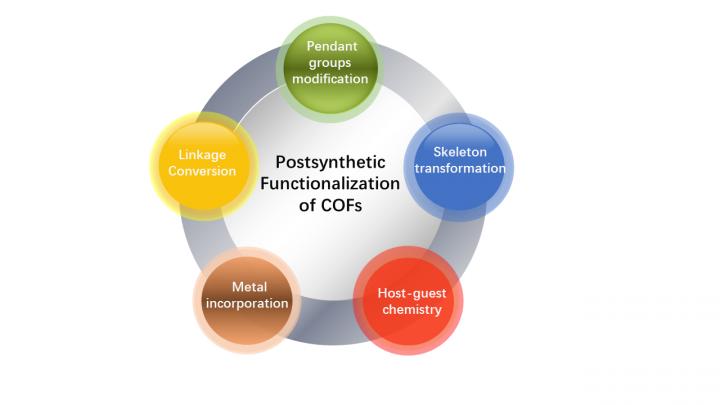
Credit: ©Science China Press
Covalent organic frameworks (COFs) are robust crystalline porous polymer with predictable structural composition and functions. The bottom-up synthesis of COFs allows for incorporation of reactive pendant groups and other active sites within their skeleton. On the other hand, the strong covalent bonding stitching the organic building blocks in COF frameworks secure the high chemical and thermal stabilities of the compound into high extent. These facts garner the judicious postsynthetic functionalization in COFs to introduce new functions with controlled manner.
Recent development of the postsynthetic functionalization of COFs has successfully introduced wide ranges of organic to inorganic functional constituents into COFs to obtain the desired functionalized-COFs. This functionalization involves the formation of specific bonds (covalent and coordination/ionic bonds), chemical reaction (oxidation/reduction reaction) and host-guest interaction between the COFs and functional constituents. As the result, several organic functionalized-COFs, metal/COFs hybrids and other material based-COFs have been reported so far.
In a new review published in the Beijing-based National Science Review, a research group at the State Key Laboratory of Inorganic Synthesis and Preparative Chemistry, chemistry department of Jilin University, China summarizes the recent progress of postsynthetic functionalization of COFs. Co-authors Yusran Yusran, Hui Li, Xinyu Guan, Qianrong Fang and Shilun Qiu trace the courses of postsynthetic functional development in COFs and elaborate comparatively the contribution those functionalizations over the structural qualities and performances of the resultant functionalized-COFs towards specific applications.
These authors emphasize the paramount important of the functional development of COFs for creation COF-based smart materials and outline the challenges in their future development
“The most prominent property of COFs is their high chemical stability that surpass the former porous material such as inorganic zeolites and MOFs, which signals the robust postsynthetic functionalization in COFs to be executed,” the authors emphasize in an article titled “Postsynthetic Functionalization of Covalent Organic Frameworks.” “Although the desired functionalized-COFs can be achieved via bottom-up approach, postsynthetic functionalization provide more reliable approach with better controlled,” they add.
The first example of postsynthetic functionalization of COFs is traced back in 2011, when the prepared COF-LZU1 was modified with Pd complex to obtain Pd/COF-LZU-1 hybrid. Furthermore, the authors include their works in the article for functionalization of 3D-COF-OH into 3D-COF-COOH and incorporation of metal species into 3D-Salphen-COF (JUC-509) to fabricate JUC-509-Y. “Generally, 2D COF variants are more widely synthesized and functionalized compared to 3D COFs. However, in our lab, we demonstrated the functionalization of 3D COFs with reactive pendant groups,” add the leading author.
The resultant functionalized-COFs clearly demonstrated stability enhancement as well as better performance and activity towards gas storage/separation, molecules uptake-release, catalysis, electrical storage sensing, and other important applications. “we all witness how the resultant functionalized-COFs with specific functions could do more than the bare COFs in the field of catalysis, adsorbent and other applications,” the authors state.
“In the future development of COFs, there are still many things need to develop, such as functionalization of the available linkages which is still less explored.” the authors forecast. “Functionalization of COFs via host-guest chemistry so far, are mainly explored for electronic and energy storage applications, thus investigations in wider sophisticated applications are still highly engage. Last but not the least, continuous efforts in development of functionalized 3D COFs may still need special concern,” they add.
###
This research received funding from the National Natural Science Foundation of China, the ‘111’ project, JLU Science and Technology Innovative Research Team program and the Thousand Talents program (China).
See the article:
Yusran Yusran, Xinyu Guan, Hui Li, Qianrong Fang and Shilun Qiu
Postsynthetic Functionalization of Covalent Organic Frameworks
Natl Sci Rev (August 2019) doi: 10.1093/nsr/nwz122
https:/
The National Science Review is the first comprehensive scholarly journal released in English in China that is aimed at linking the country’s rapidly advancing community of scientists with the global frontiers of science and technology. The journal also aims to shine a worldwide spotlight on scientific research advances across China.
Media Contact
Qianrong Fang
[email protected]
Related Journal Article
http://dx.




